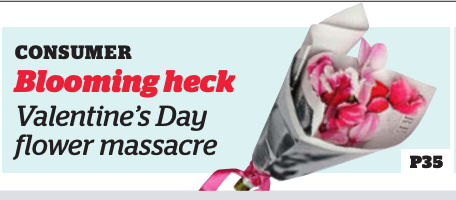The carbon cost of imported flowers is not romantic, writes Sophie Morris

If I look back through the photographs on my phone, January is always sprinkled with pictures of the first snowdrops I have spied that year. Daffodils will be next, white, yellow and golden, crowds of them in planters or tiny bunches of buds at supermarket checkouts, then pink and orange tulips. Then, suddenly, it’s the bright red roses of Valentine’s Day, jumping their queue in nature’s calendar by many months.
Whatever your take on 14 February - splendid opportunity to show someone you love them, or cynical marketing ploy for desperate romantics - its consumer symbols surround us, from heart-shaped chocolates in red foil to teddy bears and balloons and, of course, stems of red roses.
The festival is named for St Valentine, who was killed by the Roman Emperor Claudius II in AD3 for going against the ruler’s wishes and performing weddings at a time when soldiers were forbidden from marrying. The Ancient Greeks and Romans identified the rose with Aphrodite and Venus, their goddesses of love. The flower was also sacred to the Egyptian goddess Isis. This link has evolved over the years into the bouquets of red roses that fill shop windows this month.
Until a group of florists called SSAW Collective, which sells British flower subscriptions, came to me with its campaign “Why Buy Roses in February?” I hadn’t given it much thought. Bright red blooms provide a bit of colour and joy in the midst of a grey February. But the collective, founded by chef Lulu Cox alongside florists and flower farmers Jess Geissendorfer and Olivia Wilson, aligns flowers with our food and farming systems rather than being a perennial treat or show of affection.
British consumers buy 570 tonnes of roses each February. Many come from Kenya and the Netherlands, contributing to a mammoth carbon dump of 32kg of carbon dioxide per bunch. According to SSAW, a bouquet of 15 British stems produces only 1.7kg of carbon emissions, 95 per cent less. What is more, they are often sold as loss leaders.
“There is no better time to examine our relationship with flowers here in Britain,” says Geissendorfer, who grows her flowers on an Essex farm. “Flowers are a luxury, yet in a similar vein to fast fashion, there is very little transparency in the supply chain of imported blooms.
We have so many beautiful British varieties and flower farms in the UK - treating yourself to a bunch of cut flowers does not need to come at an environmental cost.”
It is not easy to source homegrown flowers in winter, but SSAW works with what it has for its subscriptions. This means narcissi and tulips when it is still frosty, then anemones and ranunculus, followed by cornflowers, peonies and - finally! - roses as we hit summer, before dahlias and hydrangeas in autumn.
Another approach is to choose dried or paper flowers, which last far longer. Styles have moved on from parched baskets of pot pourri to multicoloured bouquets to brighten your days long past February.
Try the Appreciation Project, which has Valentine’s bouquets called Flirtini and Heartbreaker in soft pastels and acid brights or, if you want to heed tradition and go red, the Diana is an array of crimson hydrangea, bunny tails and eucalyptus.
The art of making paper flowers is also becoming more popular. Camille Roman is the founder of Posy Patou and makes sculpted flower posies at her workshop in Margate, Kent.
An even cheekier prospect this year comes from the fancy grocer Natoora, in Bermondsey, southeast London, which is asking customers to “Give radicchio, not roses”, comparing the red, pink and variegated leaves of these bitter Italian lettuces to flowers.
My hunch is that we have some time before the critical mass begins to exchange clutches of salad leaves or cruciferous veg at this time of year. But I wouldn’t turn my nose up at a spray of kale and chicory.